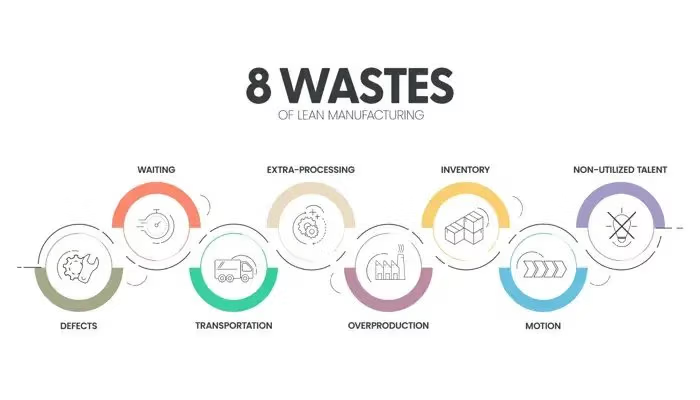Introduction to Lean Manufacturing
Lean Manufacturing is often linked with the Toyota Production System; it’s a management philosophy focusing on reducing waste and boosting efficiency overall. Its core aim is to maximize customer value while minimizing waste at every production stage. By embracing Lean Principles, companies can cut costs and effectively improve quality standards while enhancing customer satisfaction.
The Core Principles of Lean Manufacturing
Central to Lean Manufacturing lie five principles;
- Value: Determine value from the standpoint of the customer.
- Value Stream: Pinpoint and outline the entire value stream from start to finish, encompassing all product or service delivery activities.
- Flow: Maintain an uninterrupted flow of work, minimizing disruptions, delays, and bottlenecks.
- Pull: Implement a pull system that enables production to be driven by customer demand rather than projected demand.
- Continuous Improvement: Cultivate a culture of enhancement, empowering employees to identify and eliminate inefficiencies.
These principles lay the groundwork for recognizing and remedying forms of waste that can manifest in a manufacturing setting.
Ready to tackle the 8 wastes in your operations?
Discover how Manufacturing Operations Management software can streamline workflows and drive continuous improvement.
Eliminating Waste in Lean Manufacturing
Waste, known as “Muda” in Lean terminology, refers to anything that does not add value to the final product or service. In addition to Muda, Muri Lean – the overburdening of people, machines, or processes – also contributes to inefficiencies. To achieve more stable and efficient operations, companies strive to eliminate both. The following 8 Wastes of Lean represent key areas where inefficiencies must be addressed.
Overproduction Waste
Overproduction waste arises when more goods are manufactured than what is needed by the customer. This can result in inventory, heightened holding expenses, and potential obsolescence risks. Excessive production waste is considered waste as it exacerbates other types.
Transportation Waste
Transportation waste encompasses the shifting of materials or products between workstations or locations. Excessive transportation can result in delays, damage and higher costs. Manufacturing aims to reduce transportation waste by streamlining material flow and minimizing movements.
Inventory Waste
Inventory waste arises when there is excess inventory within the manufacturing process. This type of waste ties up capital and occupies space. This can lead to quality issues. Lean Manufacturing focuses on lowering inventory levels and implementing just-in-time principles to ensure materials are available as needed.
Waiting Waste
Waiting for waste is any time during the production process caused by equipment breakdowns, lack of materials, or inefficient workflows. This downtime leads to productivity and delays in meeting customer demand. Lean Manufacturing minimizes waiting waste by optimizing processes and ensuring a workflow.
Motion Waste
Motion waste involves the movement of people and equipment within the manufacturing setting. Excessive motion can result in fatigue, injuries, and decreased productivity. Lean Manufacturing addresses motion waste by optimizing workstations and reducing value-added movements.
Inefficient Processes
Over-processing waste happens when more work is carried out than necessary to meet customers’ needs. This leads to costs and time spent without adding value for the customer. Lean Manufacturing aims to spot and eliminate over-processing waste to streamline operations and enhance efficiency.
Defective Outputs
Defect waste refers to products or services that do not meet the expectations or requirements of customers. Defects lead to redoing work, discarding items, unhappy customers, and higher costs. Lean Manufacturing strives to reduce waste through quality control techniques and error prevention methods.
Underutilization of Talent
It occurs when organizations do not fully utilize their employee’s abilities, skills and knowledge. Lean Manufacturing values employees as resources. Encourages them to contribute to problem-solving and process enhancement efforts. By empowering employees and fostering a culture of learning and improvement, organizations can unleash the potential within their workforce.
Spotting Waste in Lean Manufacturing
Identifying waste in manufacturing requires observation skills and analytical thinking. Lean experts use value stream mapping, observing processes, analyzing data, and gathering employee feedback to pinpoint and measure waste in the production process. Understanding the flow of materials and information and identifying value-added and non-value-added activities allows organizations to pinpoint areas of inefficiency and prioritize improvement efforts.
Improving Workflow for Efficiency
After detecting waste, the next step involves streamlining workflow processes to enhance efficiency. This requires redesigning procedures to minimize or eliminate value-adding tasks and ensure a smooth workflow. Lean Manufacturing promotes the “pull” production principle, where work is initiated based on customer demand rather than predictions. Organizations can achieve a responsive workflow by reducing inventory levels, enhancing communication, and implementing visual management techniques.
Instances of Waste in Lean Manufacturing
Waste within manufacturing can appear across various industries. Here are some common examples;
- Material handling: Unnecessary movement of materials or equipment can result in wasted time and increased risks of damage or accidents.
- Excessive paperwork: Manual and redundant paperwork can be time-consuming and prone to errors without contributing value to the product.
- Unneeded inspections and approvals: Having layers of checks and authorizations can cause delays and extra administrative work.
- Complicated products: Creating products with many features or complexities that customers don’t find valuable can reduce costs and extend project timelines.
- Inadequate communication: Poor communication channels and practices can lead to misunderstandings, delays, and the need for rework.
By tackling these instances of inefficiency and applying principles, companies can cut costs, enhance quality and boost customer satisfaction.
Lean Construction: Implementing Lean Principles in the Construction Sector
The application of principles isn’t restricted to manufacturing sectors but extends to the construction industry, referred to as lean construction. In construction, the emphasis is on streamlining the construction process, minimizing waste and enhancing project outcomes.
The 8 Wastes in Lean Construction
Construction identifies 8 Wastes of Lean frequently observed in construction projects;
- Transportation waste: Unnecessary movement of materials and equipment around the construction site.
- Inventory waste: Stockpiling of materials or equipment without necessity.
- Motion waste: Unnecessary movements of workers or equipment during construction tasks.
- Waiting waste: Delays and downtime due to coordination issues or resource availability.
- Overproduction waste: Producing more than necessary for project requirements.
- Rework: Reducing work or excessive resource usage, avoiding rework or repairs of mistakes.
- Underutilization of worker’s skills and knowledge: Efficiently utilizing the expertise and capabilities of workers is crucial.
- Goal: Minimize delays, enhance productivity, and improve project outcomes.
Eliminating waste in manufacturing and construction brings significant benefits. It reduces costs by cutting excess inventory and inefficient processes, enhances product quality by removing defects and unnecessary steps, and boosts productivity with streamlined workflows and fewer delays. Shorter lead times and improved delivery performance increase customer satisfaction, while greater efficiency provides a competitive edge with better quality and faster response times.
FAQ | The 8 Wastes of Lean
What is Lean Manufacturing?
Lean Manufacturing is a management philosophy and set of principles aimed at eliminating waste and improving operational efficiency. It focuses on maximizing customer value while minimizing non-value-added activities, with Lean Production playing a key role in optimizing workflows and resource utilization.
Can the concept of waste be applied to service industries as well?
Yes, the concept of waste can be applied to service industries too. While the 8 wastes of Lean Manufacturing were originally developed for manufacturing environments, they can be adapted and applied to service industries such as healthcare, hospitality, finance, and transportation.
Is eliminating all waste always feasible or desirable?
While the goal of Lean Manufacturing is to eliminate waste, it is important to note that not all waste can be completely eliminated in every situation. Some waste may be inherent to certain processes or industries. However, reducing waste wherever possible leads to significant benefits, such as lower costs, higher product quality, improved productivity, and a stronger competitive advantage. Methods like 3P Lean (Production Preparation Process) help by designing efficient workflows upfront, preventing waste before it occurs.
How does Lean Manufacturing contribute to improving product quality?
It focuses on identifying and eliminating waste, which includes defects and errors in the production process. By streamlining and standardizing processes, implementing error-proofing techniques, and empowering employees to take ownership of quality, Lean Manufacturing helps in reducing defects and improving product quality. This leads to higher customer satisfaction, reduced rework, and lower costs associated with quality issues.
Can Lean Manufacturing be implemented in small businesses?
Yes, it`s principles can be applied to businesses of all sizes, including small businesses. In fact, Lean Principles can be particularly beneficial for small businesses as they help optimize resource utilization, reduce waste, and improve efficiency. The key is to adapt and scale Lean Concepts to suit the specific needs and constraints of small business operations.
How can Lean Manufacturing benefit the environment?
Lean manufacturing principles align with environmental sustainability goals by reducing waste, conserving resources, and minimizing the negative impact on the environment. By streamlining processes, eliminating non-value-added activities, and optimizing resource usage, lean manufacturing reduces energy consumption, emissions, and waste generation. Lean organizations often adopt practices such as recycling, energy-efficient technologies, and eco-friendly packaging, contributing to a more sustainable and environmentally responsible approach to manufacturing.
What role does leadership play in implementing Lean Manufacturing?
Leadership is crucial in successfully implementing it. Leaders need to provide a clear vision and commitment to lean principles, drive cultural change, and support the empowerment and involvement of employees. They should lead by example, actively participate in improvement initiatives, and provide the necessary resources, training, and guidance to foster a lean mindset throughout the organization.
Image: Adobe Stock – Copyright: © Whale Design – stock.adobe.com





